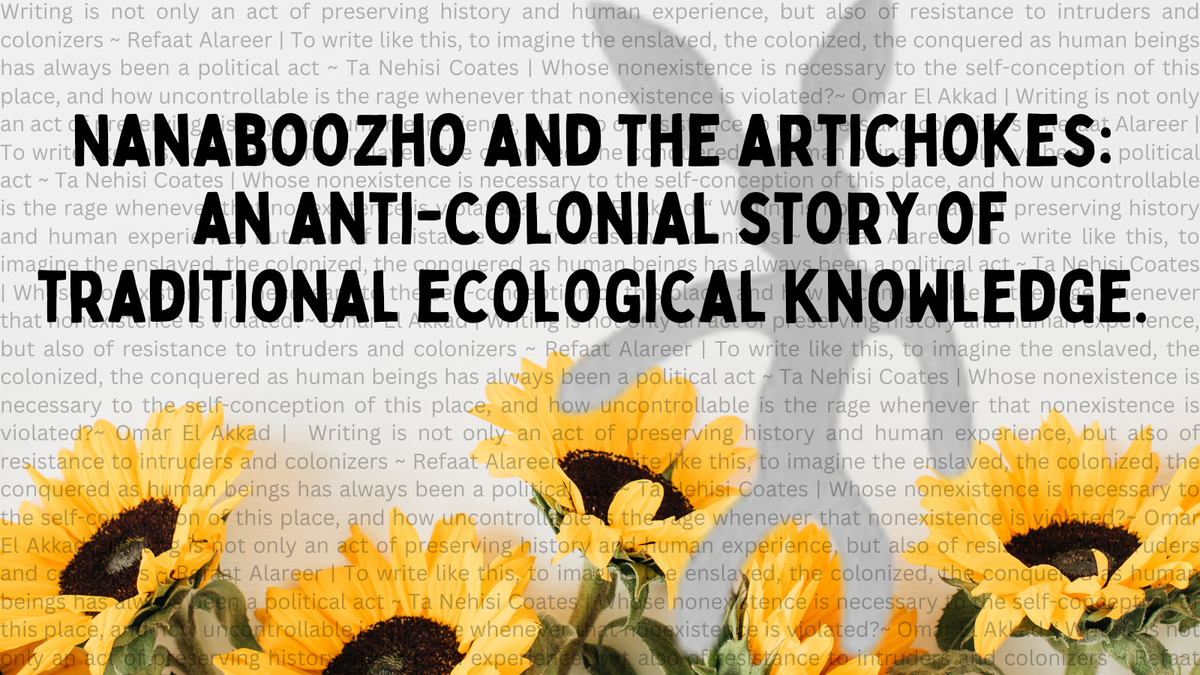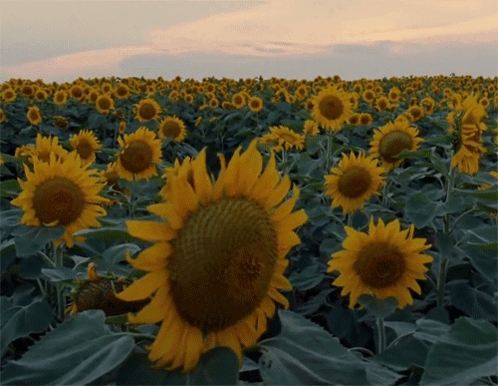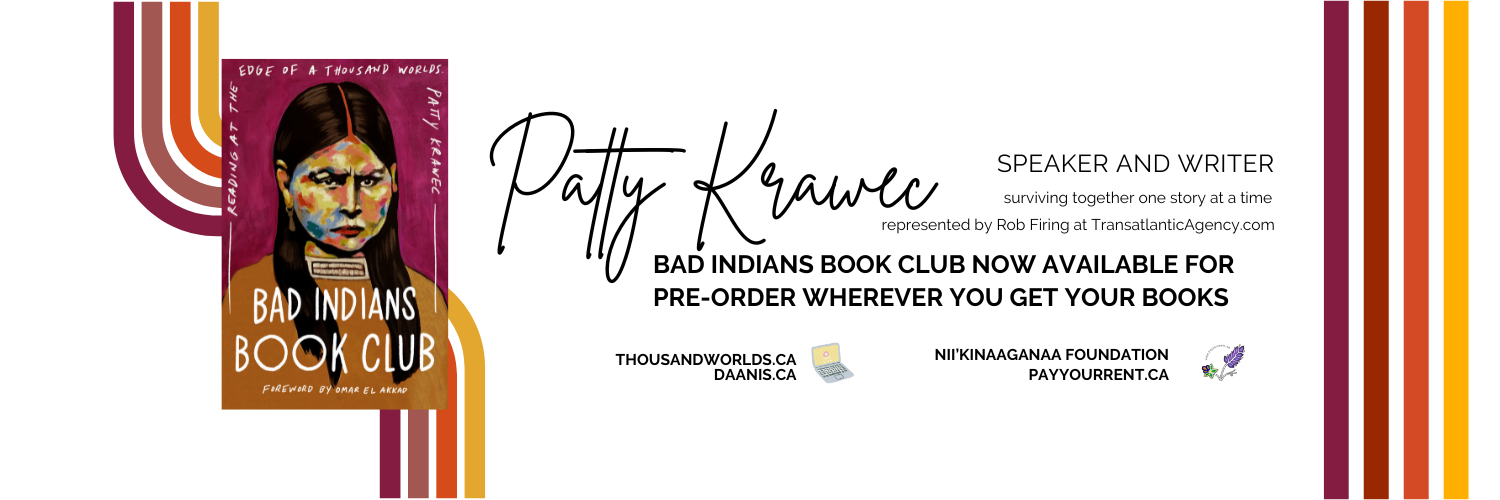Nanaboozho and the artichokes

This blogpost is dedicated to my oldest son, Ben, who planted these artichokes in our garden. You can find him on Instagram.
A few years ago I ordered a print from Isaac Murdoch. It graces the cover of his book, The Trail of Nenaboozho, and when I unpacked the print my husband asked if it was a painting of Ben. I told him it might as well be, because the two are very similar in good ways. If nothing else, Ben is an Ojibwe man who, like Nanaboozho, is deeply invested in reciprocal relationship with the other than human world. He also tends to, intentionally or otherwise, get into shenanigans. In the print Nenaboozho is lifting a plant over his head with branches and roots and who knows. Maybe it's artichokes, what the Ojibwe called ashkibwaa.
Before we go further, let me offer the chi-est of miigweches to new friend Tim! Also hello to newly signed up free members! Paid subscribers help keep the lights on, but anyone can help expand my audience by sharing this post through email or on social media. I am working my way through Ojibwa Texts by William Jones with some additional insights from The Trail of Nenaboozhoo and Other Creation Stories as well as Serpents and Other Spiritual Beings which are stories collected and told by Isaac Murdoch (Serpent River First Nation), and Gii-Nitaa-Aadisooke: Ojibwe Legends from Lac Seul collected and told by Patricia Ningewance (Lac Seul FN). Other sources are linked as they come up or included in another section about what I'm reading. By the way, these essays are not meant to be authoritative interpretations, just personal reflections.
According to Wikipedia the name "sunchoke" was invented by a produce wholesaler in the 1960's because marketing. And apparently Samuel de Champlain, the 16th century explorer who made his way down what would become known as the St. Lawrence River, thought they tasted like artichokes and sent them back to France. Within 100 years they were commonplace in Europe. You're welcome.
This week's story is about the lowly ashkibwaa, ashkibwaag in the plural. It's a silly story and lord knows we're in need of some silliness right now.
So. Nanaboozho is walking along and he sees some creatures. "Yo, can you be eaten?" Not my first choice for a greeting, but if you've ever wondered why archaic humans decided to try certain foods (looking at you mushrooms) maybe this is how it went. These creatures say "heck yeah!" and Nanaboozho asks them if there are any effects upon eating. Another curious question, but smart really. They tell him nbd just a little wind in the belly.

Nanaboozho eats them and they are tasty. Then as he's continuing on his way he hears "po" from behind him. The heck? He starts running but "po" "po" "po" continues to follow him. WHO IS THERE??? No response, just "pu" "pu" "pu". He keeps running to no avail, decides that it must be a powerful manitou, and eventually, suddenly remembers what his little brothers said when he asked them if there were any ill effects. "We make you windy." He has a good laugh, and decides that's what everybody will say now. That they are breaking wind.
Now, if you've been around any length of time at all you'll have read me waxing eloquently about Anishinaabemowin being a verb based language in which words are animate or inanimate rather than gendered. Is it alive, does it have agency, is this something that takes action or is it something that is acted upon. This matters because of the way you will conjugate the verbs is different depending on animacy. Ben says that it's more process oriented than animacy (how does a thing act rather than what it is) which makes sense. Lawrence Gross, in Anishinaabe Ways of Knowing and Being tells the very entertaining story about his moccasins that can hit him but not his socks. Apparently inanimate things like moccasins have agency even if it is unfair.
I bring this up because a friend, Caitlin Beaulieu a knowledge keeper from Peepeekisis Cree Nation, talked about their Cree language class and the discussion about whether the word for "fart" was animate or inanimate and it turns out that it depends on what you're farting at. I have no answer for whether or not these farts are animate, though he does seem to be farting at himself.

Giving this way too much thought.
Onwards.
In the second version of this story the ashkibwaag admit to causing a little pain the belly which, idk, would have been a deal breaker for me but obviously not for Nanaboozho. There are many recipes out there for these sunchokes or jerusalem artichokes including a few that recommend cooking them in something acidic to break down the inulin which is what causes the digestive carnival. These tubers are super nutritious and a low glycemic alternative to potatoes which is why Ben planted them in our garden.
Interestingly, the name "Jerusalem Artichoke" has nothing at all to do with Jerusalem, the plants are native to the so-called Americas. The name is a corruption of the Italian word girasole that means sunflower, because sunchokes are a kind of sunflower which reminds me of a story that Catawba artist and activist DeLesslin told us a few years ago on Medicine For The Resistance. DeLesslin is involved in language, food sovereignty, and the culture and lessons that come alongside that.
In that conversation, DeLesslin told us a story about rabbit, fire, and sunflowers. Rabbit had seen the buzzards with fire and wanted some for himself but in the process he lit his foot on fire. He took off to the stream and somehow managed to set the woods on fire. So there he sits, crying and distraught over what he did but others comforted him saying no, dude, we have beautiful grassland now. And look! Sunflowers!
Which are edible from petal to tuberous root.

The Schweinitz’s sunflower is native to areas of the so-called Carolinas and despite their preference for dry soil with minimal nutrients, they are endangered because humans also like dry hilltop locations and grasslands. I mention this because while it's a silly little story about how Rabbit got fire for the people, it also encodes controlled burn practices and agriculture. Burn the underbrush, the overgrown grasslands, get edible sunflowers that grow without minimal care. Because while these aren't exactly the same as their cousins, the ashkibwaag, they are related and these plants will take over any dry sunny location you give them. Kind of like humans.
We are all familiar with the neolithic revolution that took place in Mesopotamia. That's when all the hunter/gatherers sat down and became farmers. Finally! Civilization! Except that Mesopotamia was not the only place where there was an agricultural revolution and it really isn't part of some kind of linear progress narrative. This kind of agriculture is a response to population density because as Ben has pointed out to me, foraging is great but there really isn't enough forage to go around unless we want to wipe everything out. Societies tend to operate cyclically, when the population gets dense they turn towards more structured agriculture and some kind of animal husbandry. When populations thin out they go back to hunting and foraging. Both involve a fair bit of work because if you want the forest to provide for you then you have to take care of it and practice some forms of cultivation even if they don't look like European agriculture.
Agricultural revolutions happened in the Americas as well, there are at least two and possibly three instances. In his book 1491, Charles C Mann writes about the first Neolithic Revolution which saw teosinte transformed into maize over a very long period of time. He notes that the wild species that became the grains of the Mesopotamiam revolution look much like their agricultural cousins, but maize does not (in any way, he says) resemble teosinte. It had to be deliberately cultivated and combined in ways and over time that wheat, rice, millet, and barley did not. And it required a very long vision. Elsewhere in Mesoamerica a second agricultural revolution took place with plants like squash, and we know that both maize and squash moved across the Americas transforming the lives of a number of tribes to the point that many creation stories as far as the eastern seaboard include maize as part of their emergence as people.
In the Eastern Agricultural Complex, at whose edges the Catawba and Anishinaabe emerged, a third form of agriculture evolved with the cultivation of squash, sumpweed, erect knotweed, maygrass, little barley, lambsquarters, and sunflower. These stories we are talking about today bring sunflower, ashkibwaa, into our creation story, because like fire, these tuberous, nutritionally dense plants changed our world. And put wind in our bellies.
All we are is story.
~ Richard Wagamese
In the papers that Yousef M. Aljamal collected and curated into the posthumously published If I Must Die, poetry and prose by Refaat Alareer there is an essay with Alareer's reflections on Gaza Writes Back a collection of short stories by young writers in Gaza. In that essay he says that "stories teach life." Writing, he says, is "not only an act of preserving history and human experience, but also of resistance to intruders and colonizers." Ta Nehisi Coates says something very similar in The Message, his book to the young writers he teaches, when he says that "to write like this, to imagine the enslaved, the colonized, the conquered as human beings has always been a political act." And throughout One Day, Everyone Will Always Have Been Against This, Omar El Akkad writes about the importance of writing back against narratives of erasure. He says, "whose nonexistence is necessary to the self-conception of this place, and how uncontrollable is the rage whenever that nonexistence is violated?"
Storytelling, writing, is a potent strategy against nonexistence and it is easy to see contemporary writing like that of Alareer, Coates, and El Akkad as having a political purpose but so do these older stories. The William Jones collection that I am using for this series was documented in 1906 when there were significant shifts taking place in the Ojibwe communities around Lake Superior. Residential schools were becoming if not mandatory then not exactly optional either, in and out of school missionaries were pushing our stories aside in favour of the Bible. Our stories about encounters with the spiritual world around us and our emergence as a people were at best relegated to myths and legends, at worst they are described as pagan or even demonic, while their own stories about ancient Hebrew encounters with the spiritual world and their emergence as a people were Truth.
I once sat with a couple of foster parents who wanted some advice on caring for the Mohawk children in their homes. When one of them told me that the foster agency (a private, Christian agency) had given them some books she said she didn't like reading those stories, giving the example of a story about how the chipmunk got its stripes. I asked her what she didn't like about that story and she said that wasn't how God created chipmunks. The story posed a threat to her understanding of how the world operated. It offered an alternative world view that she did not want available to the young children in her care.
Stories do pose a threat to our understanding of how the world operates. If I read Alareer, Coates, and El Akkad correctly that's exactly what they are supposed to do. That's why we engage with them, talk abut them, wrestle through those challenges and in the process we remake ourselves again and again. But that isn't what this woman wanted, she had put our stories beyond redemption and wanted to know how she could get absolution for instilling what she saw as correct beliefs into Mohawk children.
Traditional Ecological Knowledge (TEK) is the umbrella term for the collection of knowledge and practices about how we fit together with the natural world. It is specific to locations and the peoples who emerged from them. These stories are part of that knowledge base along with many others. In her collection, Indigenonous Critical Reflections on Traditional Ecological Knowledge, Lara Jacobs pulls together poetry and prose from around Indigenous people around the world exploring the Indigenous value systems--relationships, reciprocity, and responsibility--that are fundamental to Indigenous Knowledge systems and cultures. What as fascinating to me in this was not just the breadth of Indigenous ecological knowledge, I mean, contrary to everything we've been taught white european men didn't invent science, what was fascinating was the way that many scientists reflected on their own responsibilities in doing work outside of their own communities. Every contributor includes a position statement, who they are, so that we can have that context through which to hear their words.
These small stories, Nanaboozho and the artichokes, Rabbit and fire, contain traditional ecological knowledge. This knowledge is part of our stories because stories are how we pass on knowledge. But they aren't meant to be read in isolation the way I am doing here. Stories are meant to be told in community, they are part of our shared world and a vision for how to live well within it.
I want you to imagine yourself as a small child out walking with your Nokomis in her floral dress and rainboots, a scarf wrapped around her head. I want you to imagine yourself carrying a small basket and while she's showing you the woody stalks and directing you in digging out the fibrous tubers from under ground she's telling you this story about Nanaboozho and the artichokes filling in all kinds of details. She's telling you about the landscape that the story takes place in, what plants and geography to look for in order to find them, how to take care of the ground so that next year there will be more of them. I want you to imagine yourself in her kitchen while she shows you how to clean them and prepare them for dinner so you don't get too windy. Think about yourself running around the kitchen amidst shared laughter at Nanaboozho running away from his own farts.
I want you to close your eyes and feel the warmth of the sun on that dry hilltop, smell the fat heating up in a cast iron skillet so well seasoned you could use it as a mirror. I want you to imagine telling this story to your own children and grandchildren while you walk with them to the same hilltop, maybe carrying the same knife your Nokomis used to help you pry out these roots. And I want you to smile, knowing how very much this story contains about the world we used to live in and what may yet be.

You can listen to me talk about Becoming Kin and Bad Indians Book Club on the missing witches podcast! Rissa was such a delight to talk with that it had to be split into two episodes. Episode one: What if we stayed in the margins? Episode two: We survive together or not at all. Listen with these links on your computer or subscribe in whatever podcast app you use. And if you have a podcast you'd like to invite me on to, let me know!
Critical Reflections On Indigenous Traditional Ecological Knowledge, edited by Lara A. Jacobs. I was tickled when Lara asked me to endorse this book, and I love it. Indigenous Peoples have shared values, but we live them out in ways that reflect the places where our Tribes emerged as People and the communities in which we live. Lara Jacobs has created a touchstone in these collected essays and reflections from Indigenous Peoples throughout the so-called Americas and beyond, giving voice to the various ways we live out relationships, reciprocity, and responsibility.
Our Knowledge is Not Primitive by Wendy Makoonz Geniuz is a wonderful book describing the botanical knowledge of Anishinaabe people. We preserved our knowledge in stories and culture, encoding in ways that made it available and helped it to grow but were not legible to enlightenment thinkers as knowledge.
Muneera and the Moon: Stories Inspired by Palestinian Folklore, by Sonia Sulaiman. What a beautiful little book. Sonia's work in sifting through and cleaning up orientalist versions of Palestinian stories is driven by her love of her people and the land that knows them.
The World We Used to Live In: Remembering the Powers of the Medicine Men, by Vine DeLoria Jr. I've recommended this book before and I'll recommend it again because the world we used to live in is not that far out of reach.
A Stranger's Journey: Race, Identity, and Narrative Craft in Writing by David Mura. A guide to writing memoir with an emphasis on thinking about who we are and what our experience is within the larger world. Writers like El Akkad, Coates, and Alareer do this, we should all do this.


And don't forget to join up with the Nii'kinaaganaa Foundation. Every month we collect funds from people living on Indigenous land and redistribute them to Indigenous people and organzers. You can find out more information on the website which is now powered by ghost, which means that you can become a subscriber there just like you are here!
